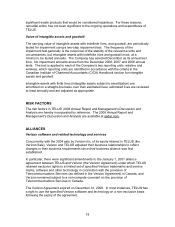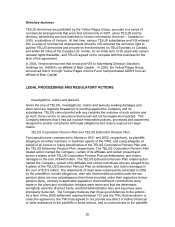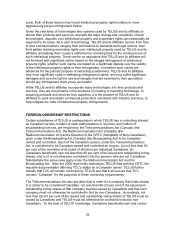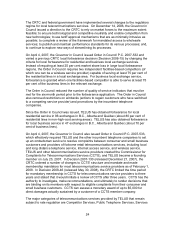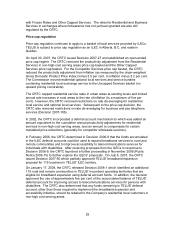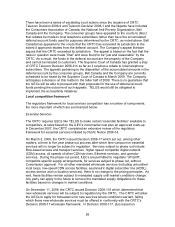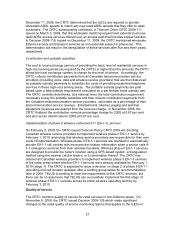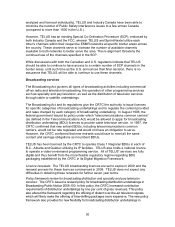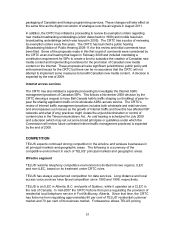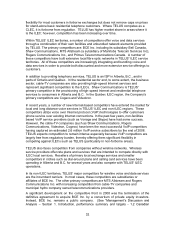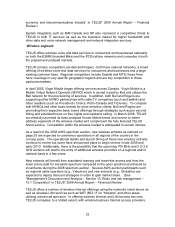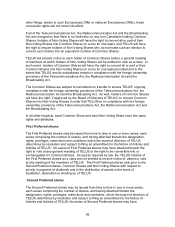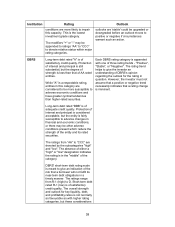Telus 2008 Annual Report Download - page 29
Download and view the complete annual report
Please find page 29 of the 2008 Telus annual report below. You can navigate through the pages in the report by either clicking on the pages listed below, or by using the keyword search tool below to find specific information within the annual report.“Management’s Discussion and Analysis – Section 10. Risks and risk management –
10.3 Regulatory” in TELUS’ 2008 Annual Report – Financial Review).
Spectrum auction. On February 16, 2007, Industry Canada released a discussion paper
for the then-upcoming auction for AWS spectrum in various spectrum bands. On
November 28, 2007, the Minister released a policy framework on how the auction would
be conducted. The major elements included a set aside for new entrants of 40 MHz of
the available 90 MHz of AWS spectrum, mandated roaming, and mandated tower and
site sharing requirements at commercial rates subject to binding arbitration. On
February 27, 2008, Industry Canada clarified its decision on roaming indicating that new
entrants are required to build before roaming and that resale will not be mandated, but
rather left to commercial negotiations between relevant parties. Terms of roaming and
tower and site sharing will be based on commercial terms and subject to binding
arbitration where commercial negotiations are not successful. Final conditions of licence
were subsequently released on February 29, 2008. The auction began on May 27, 2008
and ended July 21, 2008.
TELUS was successful in obtaining AWS spectrum licences covering a national footprint
and will have increased capacity for advanced wireless services. Besides Rogers and
Bell Canada, licences were provisionally awarded to several new wireless service
providers including Shaw Communications Inc., Quebecor Media Inc., Globalive
Wireless LP., Bragg Communications Inc., Data & Audio-Visual Enterprises Wireless
Inc., BMT Holdings and six smaller firms.
700 MHz Spectrum: The U.S. had a spectrum auction for the 700 MHz spectrum in early
2008. This spectrum is currently assigned to over-the-air broadcasters and became
mobile in the U.S. in 2009. The CRTC has set a shut-down date for analog television
transmission in Canada by August 31, 2011. After this date, no licences for analog
transmission will be issued or renewed, thereby eventually freeing up this spectrum. On
January 19, 2008, Industry Canada initiated an auction consultation process for
spectrum at 700 MHz strictly covering public safety usage. A consultation process for
commercial use is expected to be announced before the analog TV shut down in 2011.
There is no guarantee that the Canadian government will not reserve spectrum for new
entrants or that it will not, as was done in the U.S., adopt some elements of open access
for some of this spectrum.
2.5/2.6GHz: Industry Canada had previously announced plans to auction certain
unlicenced spectrum at 2.6GHz and clawback spectrum at 2.5/2.6 GHz for mobile and
fixed wireless services. A consultation on this spectrum is expected to be announced,
presumably sometime between 2009 and before expiration of current licences in 2011.
TELUS does not currently hold spectrum in these bands.
800 MHz Re-banding: In 2004, the FCC released a Report and Order adopting a plan to
resolve interference to public safety radio systems in the 800 MHz band in the U.S.
Sprint Nextel’s ESMR system was identified as the primary contributor of this
interference. The U.S. is planning to realign the band so that Public Safety systems
would be relocated to the bottom of the 800 MHz band and Sprint Nextel’s ESMR
system would operate in the upper part of the band.
In Canada, the TELUS Mike (ESMR) network also uses this same frequency spectrum.
Because of the way licensing is carried out for the Mike network (i.e. each site is
29


